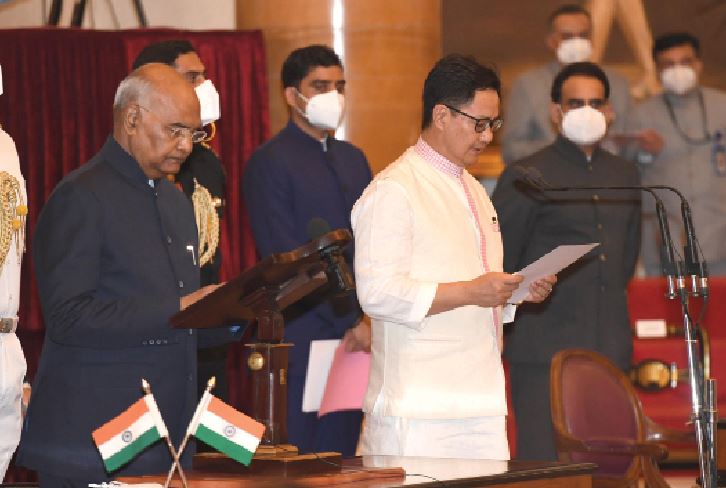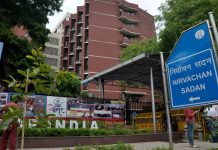Had the Cabinet reshuffle not happened, focus would have perhaps remained on Swamy’s death with international bodies like the United Nations Commission for Human Rights and United States Commission for International Religious Freedom pitching in
The dust on Stan Swamy’s controversy had not settled when focus shifted from the Jesuit priest’s death to Prime Minister Narendra Modi’s Cabinet expansion.
It may be recalled that Father Stan Swamy, a tribal rights activist was arrested in the Elgaar Parishad case last year.
He died on July 5 in a Mumbai hospital. The National Investigation Agency had arrested Swamy in October last year on grounds of his alleged links with Maoists forces and his involvement in violence during January 2018 events to mark the 200th anniversary of the Battle of Bhima Koregaon. The Narendra Modi government got flak for its apathy and failure to provide the necessary medical services leading to Swamy’s death.
Had the Cabinet reshuffle not happened, focus would have perhaps remained on Swamy’s death with international bodies like the United Nations Commission for Human Rights and United States Commission for International Religious Freedom pitching in.
Even while the Government sought refuge in the due process of law being followed spiel, the fact remains that on Swamy’s death the Government was in the eye of a storm.
Had the Cabinet reshuffle not happened, the spotlight would have remained on Stan Swamy’s death and the Government’s role and inaction.
While it is debatable whether the Cabinet expansion was timed to shift focus from Swamy or held as per schedule, it is true that the mammoth exercise did push the Swamy controversy into the background. Almost immediately the headlines changed and Stan Swamy was replaced by the new faces that Modi had inducted and those that he had axed.
In fact, the last was the ultimate surprise. The resignation, the first in line, of Union Minister Thawarchand Gehlot, did give rise to speculation whether more would follow. Also, Gehlot being sent as Governor was enough indication that exits, if any, would be perhaps honorable. In any case, it was beyond anyone’s imagination, including news hounds claiming “inside information” that they would be in the scale in which they actually happened; or that the prominent faces of the Modi government would bear the brunt.
Gehlot’s resignation was followed by Union Ministers Ramesh Pokhriyal, D.V.Sadanand Gowda and a handful of ministers of state including Santosh Gangwar putting in their papers.
However, these were mere ripples. The bombshell, at least till another that followed later in the evening, was Union Minister Harsh Vardhan’s exit.
Harsh Vardhan, it may be recalled, was in the forefront in the fight against the pandemic.
Even though the government messed up the second surge onslaught, preparations were on, to meet the challenge of the third surge: the threat looming large, though there are many if’s and but’s to it.
That Harsh Vardhan was made a scapegoat is a given. It is well known that during the pandemic it was the Prime Minister’s Office and not the Health Ministry that handled everything. Therefore, to blame Harsh Vardhan for the mess is not only unfair but also uncalled for.
But then, Harsh Vardhan is not among Modi’s favourite ministers so for the Prime Minister to go out of the way to accommodate him is asking for the moon.
Yet, showing Harsh Vardhan the door served a dual purpose: it was to oust a man who did not fit into Modi’s definition of efficiency and two it was to send a message that things after all did go wrong during the pandemic; non-delivery did not fit into Modi’s scheme of things and hence could not go unpunished.
On the last, opinion is divided: if critics are smug about admission of failure, Modi-ites feel that admission is better than denial. Also, it signals the Government’s willingness towards course correction.
Irrespective, Harsh Vardhan is out in the cold. However, his consolation prize is that he is not the only one. Ofcourse his being in the ranks of Gehlot, Gangwar and company was not good enough because, at least among them, he is the tallest.
The fact that senior Ministers like Prakash Javadekar and Ravi Shankar Prasad were axed could provide some comfort and comes as a kind of a face saver for Harsh Vardhan. Unlike Harsh Vardhan who is being seen as a fall-guy, there are questions galore on where the high-profile ministers faltered.
In this context, another name that is being mentioned is Union Minister Piyush Goyal’s. The plum Railway portfolio was taken away from him.

In the forefront of this Government’s work agenda, Goyal’s has been a story of tears. The last time the Cabinet was formed, he was upstaged by Union Minister Nirmala Sitharaman when she was entrusted with the crucial Finance portfolio. That Goyal was an aspirant is common knowledge but he had to make do with Railways.
This time around, it was worse. The Railways portfolio was taken away and he had to make do with additional charge of a non-descript Textiles Ministry while retaining Commerce and Industry et all.
Goyal getting Textiles also meant Union Minister Smriti Irani being divested from one of her two portfolios. Irani who held dual charge of Textiles and Women and Child Development is now left with only one portfolio.
Like Goyal, her first snub came in the first round of Modi’s Cabinet formation.
Having emerged as a giant killer in 2019 Lok Sabha elections after defeating Congress scion Rahul Gandhi in his pocket borough Amethi, Irani was expecting a big ticket. But she was handed a lollipop by way of Textiles and Women and Child ministries.
This time around, a part of that lollipop was also taken away with Textiles going to Goyal: a downgrade for both: for Irani because instead of two she is left with only one Ministry; for Goyal to be shunted out from an important ministry like Railways to an insignificant Textiles ministry and that too as an additional charge. Whether this was to cut Irani to size or to bring Textiles and Commerce under one umbrella remains debatable.
Outspoken and a trifle aggressive, Irani has rubbed many in the BJP the wrong way. That apart, she courts controversy at the drop of a hat.
Whether it is public outrage over Dalit research scholar Rohith Vermula’s suicide wherein the Ministry was under fire for pushing punishment for Dalit students or her own educational qualifications being under scrutiny, Irani spells trouble. However, one cannot undermine her oratorical skills or her ability to lead from the front. Yet, the past few years have seen her go down, even if not out.
Another interesting aspect of the Cabinet expansion is the creation of a new Ministry namely the Ministry of Cooperation: a nomenclature which is pretty confusing given that it does not match the work carved out for it.
Aimed at strengthening the cooperative movement in the country, the Ministry aims to provide a separate administrative, legal and policy framework, simplify processes and ensure ease of doing business for cooperatives.
Even though the nitty gritty has yet to be worked out, the new ministry, according to an official statement, is created for realizing the government vision of ‘sahkar se samriddhi’: whatever that is supposed to mean.
Irrespective the government seems to have bungled on its word usage. English not being its strong point, it has failed to distinguish between cooperation and cooperatives, perhaps, treating them as synonyms.
If the Ministry aims to bring Cooperatives under its ambit, which according to an official statement it does, then the word cooperation is a misnomer.
Ofcourse an average bureaucrat could have corrected this anomaly, but like it is the Government’s style they were, perhaps, kept out of the loop. That Union Minister Amit Shah has been named its Minister is enough indication that there is more to it than meets the eye.
While on surprises, the recent expansion had a bagful.
Though aspirants waited with bated breath for that “one phone call” that could alter their political destiny, those who were part of Modi’s Cabinet, had no inkling that this expansion was as much about new entrants as it was about those who were shown the door.
It is perhaps rare that a Cabinet expansion has seen a dozen ministers resigning, particularly high-profile ones like Law Minister Ravi Shankar Prasad, Environment Minister Prakash Javadekar and Health Minister Harsh Vardhan followed by Labour Minister Santosh Gangwar, Education Minister Ramesh Pokhriyal “Nishank” and Ministers of State Babul Supriyo, Debashree Choudhary, Ratan Lal Kataria, Pratap Sarangi and Sanjay Dhotre.
Interestingly, the recent reshuffle was more about the exits than the entrants: the resignations made more news than those who signed in.
However, one cannot overlook the nuances of the recent expansion and the political messaging that comes with it. In the first round were those waiting to be rewarded beginning with Jyotiraditya Scindia who had recently crossed over to the BJP and helped it topple the Congress led state government in Madhya Pradesh. A Gandhi loyalist, time came full circle for the young Scindia when he was handed over a Cabinet rank and the Ministry of Civil Aviation: a portfolio that his late father Madhavrao Scindia had once held. Madhavrao Scindia, it may be recalled, had died in an aircrash in 2001.
To simply see his induction as a quid pro quo would be undermining his administrative capabilities. A five-time Member of Parliament, Scindia has been a Union Minister and minister of state in the UPA governments. A Harvard graduate, Scindia did his MBA from Stanford Business school. Suave and endearing, the blue-blooded Scindia is informally addressed as Maharaj.
Another person to be rewarded is BJP’s very own Sarbananda Sonowal who was inducted because he made way for Congress’s Himanta Biswa Sarma to take over as Chief Minister in his home state Assam. That apart, Sonowal has earlier served as Union Minister in the Modi government and brings with him enough administrative experience. His strong roots in Assam and his tribal identity could prove to be an asset for the Modi government.

Another person to significantly gain from the expansion is Hardeep Singh Puri, seen as Modi’s points-person in executing the controversial Central Vista project. Even while passing over one of his portfolios, Civil Aviation, to Scindia, Puri has been entrusted with Petroleum in addition to Housing and Urban Affairs. A former diplomat, he has also been upgraded and given a Cabinet rank. Some of the other gainers are Anurag Thakur, Kiran Rijiiju and Mansukh Mandaviya among others.
Having been entrusted with the Health portfolio, Mandaviya’s challenge is huge given that the pandemic is far from over and would raise its head time and again. Add to that the onus of carrying forward the vaccination drive and washing of the stains of the past where people died by the minute following the second surge.
Of the 43 ministers that he has inducted, Prime Minister Modi has taken care to maintain the regional and caste balance. He has also kept an eye on the forthcoming state elections scheduled next year.
The new look Cabinet includes a dozen Scheduled Castes ministers, 27 belonging to Other Backward Classes, eight Ministers belonging to the Scheduled Tribes and five Ministers belonging to minority communities. Among minorities, care has been taken to include one each from the Muslim, Christian, and Sikh communities in addition to two Buddhists.
There are significant inclusions from the North East with a minister each from the region: Tripura, Manipur, Arunachal Pradesh and Assam namely Pratima Bhowmick, Rajkumar Ranjan Singh, Kiran Rijiiju and Sarbananda Sonowal respectively.
Women ministers number at 11 in the Modi government with two Cabinet Ministers and nine Ministers of State. While this would dispel criticism about the scanty representation of women in the first round of Modi’s Cabinet, it would also send the right signal to women voters. From merely two Cabinet ministers in the first round, following the resignation of Harsimrat Singh Badal, the number of women ministers currently stands at seven. Prominent among them are Nirmala Sitharaman, Smriti Irani, Shobha Karandlaje and Anupriya Patel among others. Being an ally, Patel, in one sense, fills in for Badal. The Shiromani Akali Dal, it may be recalled, had severed ties with the NDA following the farmers’ agitation. Patel belongs to Apna Dal.
Attention has been given to states where elections are due given that there are seven ministers from the state of Uttar Pradesh; Ajay Bhatt from Uttarakhand and two Cabinet ministers from Gujarat namely Mansukh Mandaviya and Purushottam Rupala. Darshana Jardosh was also inducted as Minister of state from Gujrat quota so to say.
West Bengal and Maharashtra have been represented well with four ministers from the state that the BJP lost to Mamata Banerjee recently and an equal number from Maharashtra led by former Chief Minister and Maratha strongman Narayan Rane.
Having said that, delivery and governance would be the key in the next two years of the Modi government.
The aftermath of the second surge is unlikely to die soon and the government has not only to erase the stains but inculcate a trust quotient between the government and its people. Therefore the next two years will not be about governance alone but to build bridges and reinvent the Modi brand among the electorate. While this would need political craftsmanship, it would also need concrete results and bringing to life the achche din slogan. Therefore a Cabinet rejig, though desirable, is a baby step.
The Modi government has, to put it mildly, got a beating. There is a trust deficit and the Government will have to bend over backwards to convince the people that their welfare and not its own is at the root of its governance model. Simply depending on the axiom that time would heal wounds could be fatal.
The answer, therefore, lies in a focus shift from winning elections to making lives better. That would, perhaps, need a magic wand to say the least. (ends)
tehelkaletters@gmail.com












